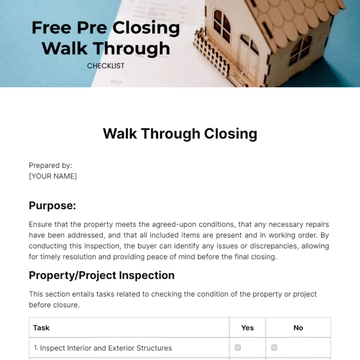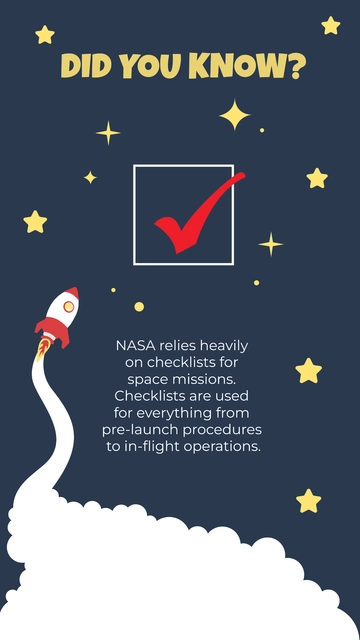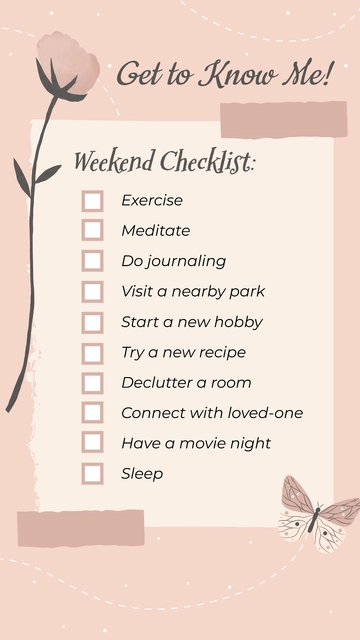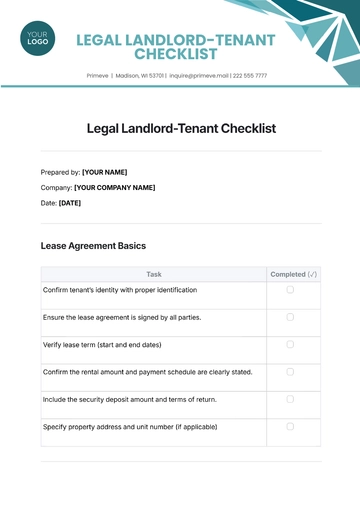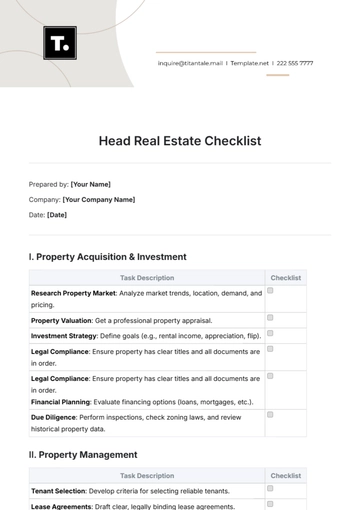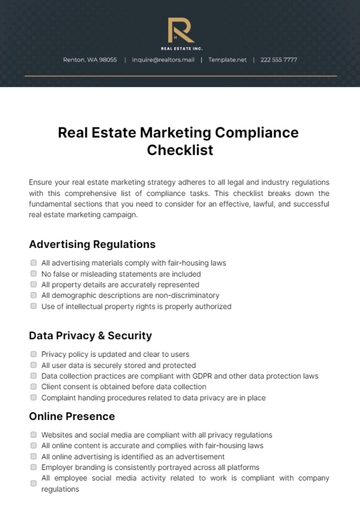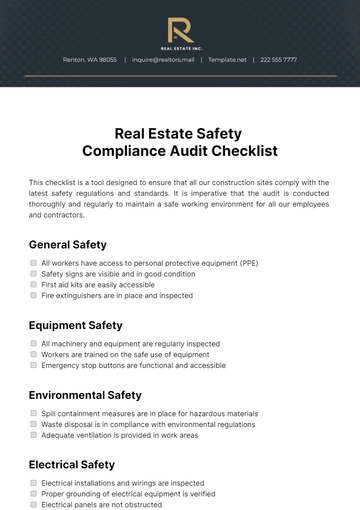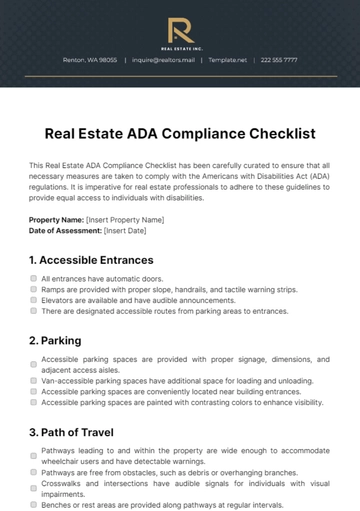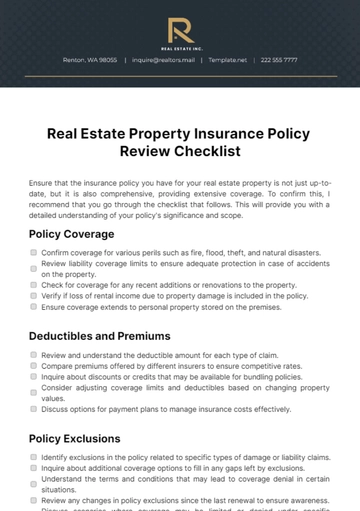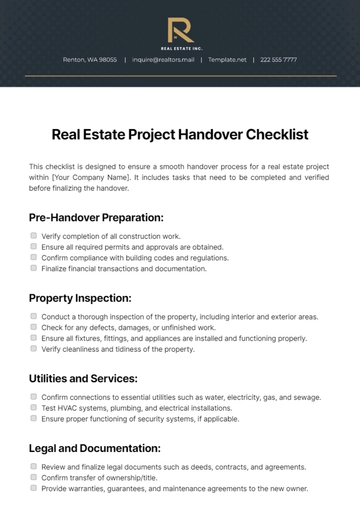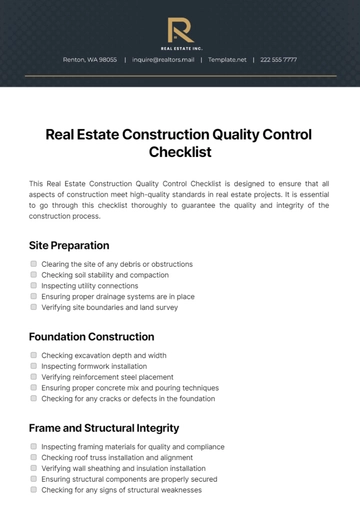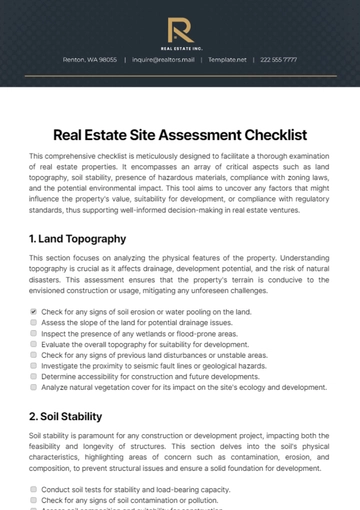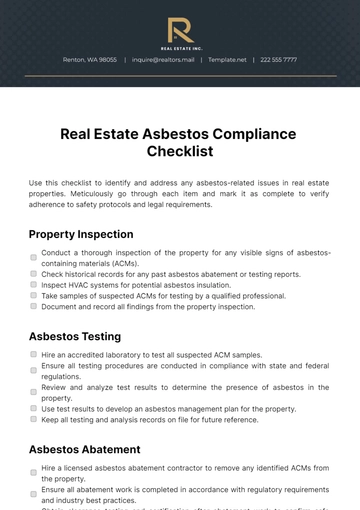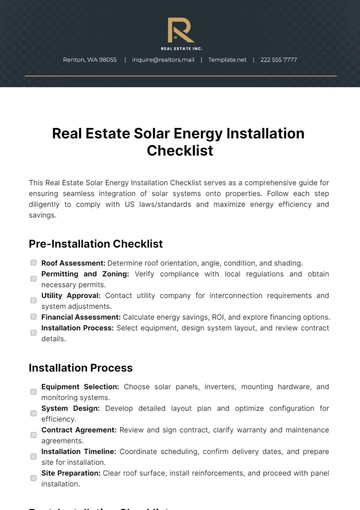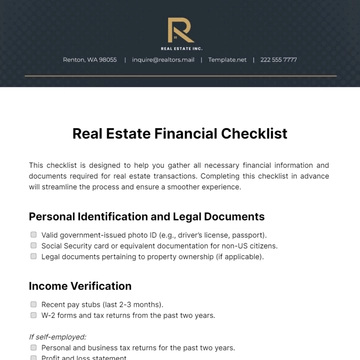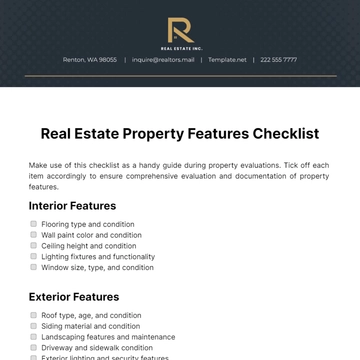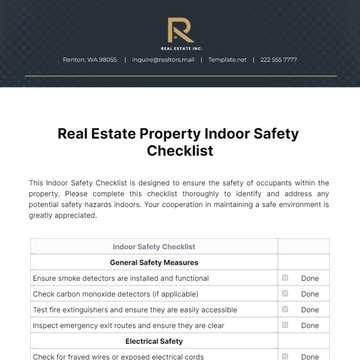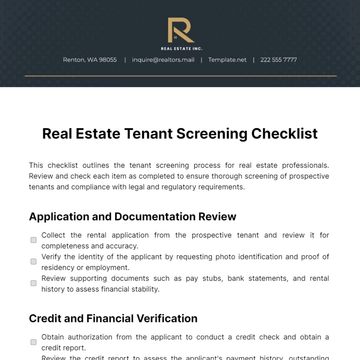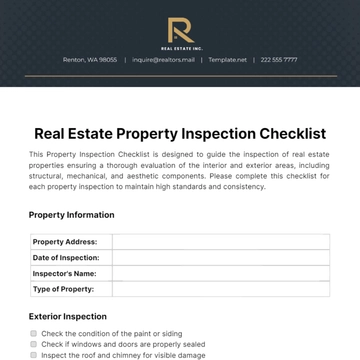Free Real Estate Outdoor Safety Checklist
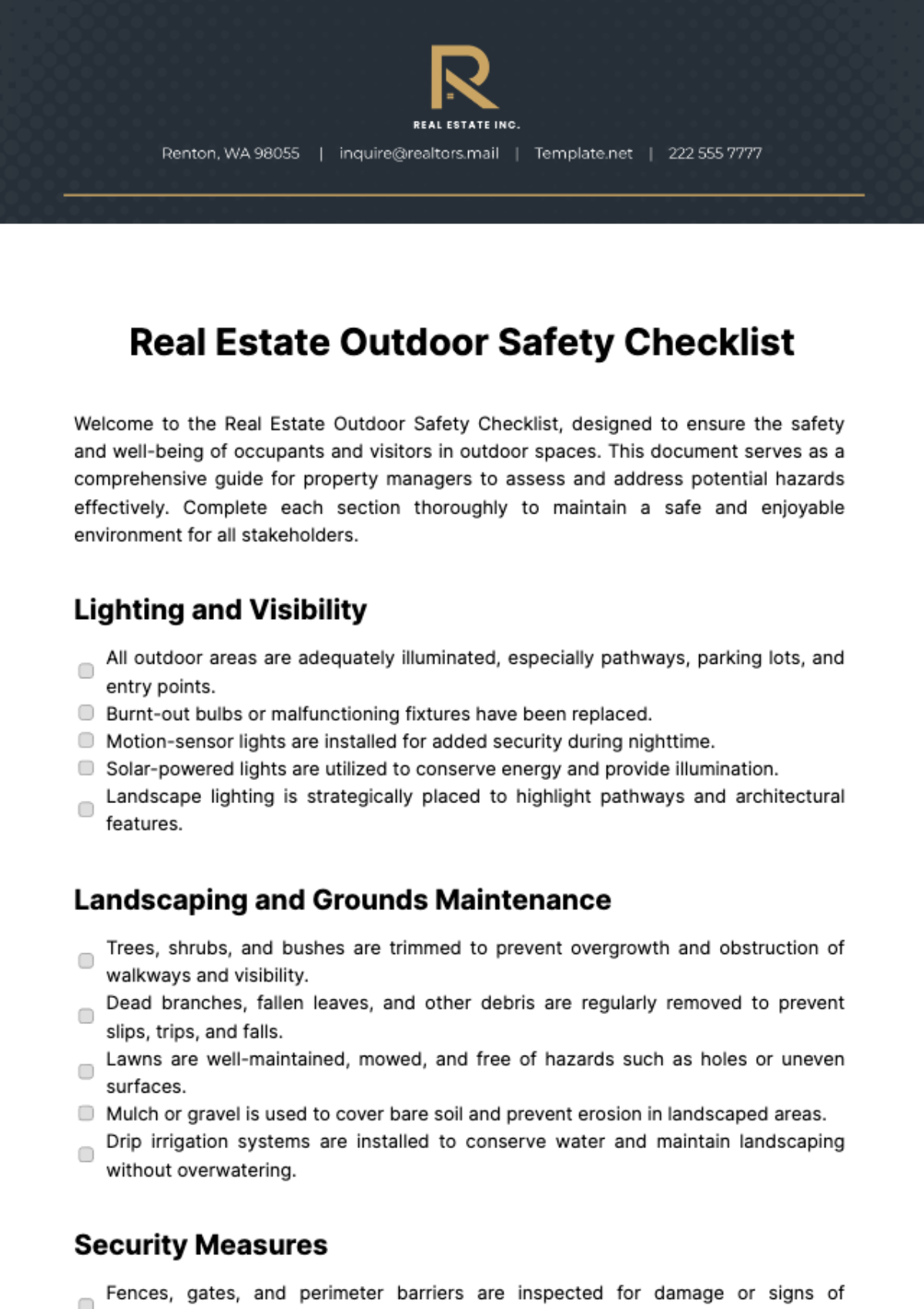
Welcome to the Real Estate Outdoor Safety Checklist, designed to ensure the safety and well-being of occupants and visitors in outdoor spaces. This document serves as a comprehensive guide for property managers to assess and address potential hazards effectively. Complete each section thoroughly to maintain a safe and enjoyable environment for all stakeholders.
Lighting and Visibility
All outdoor areas are adequately illuminated, especially pathways, parking lots, and entry points.
Burnt-out bulbs or malfunctioning fixtures have been replaced.
Motion-sensor lights are installed for added security during nighttime.
Solar-powered lights are utilized to conserve energy and provide illumination.
Landscape lighting is strategically placed to highlight pathways and architectural features.
Landscaping and Grounds Maintenance
Trees, shrubs, and bushes are trimmed to prevent overgrowth and obstruction of walkways and visibility.
Dead branches, fallen leaves, and other debris are regularly removed to prevent slips, trips, and falls.
Lawns are well-maintained, mowed, and free of hazards such as holes or uneven surfaces.
Mulch or gravel is used to cover bare soil and prevent erosion in landscaped areas.
Drip irrigation systems are installed to conserve water and maintain landscaping without overwatering.
Security Measures
Fences, gates, and perimeter barriers are inspected for damage or signs of tampering.
Locks, latches, and security hardware are in good working condition.
Security cameras and alarms are installed in strategic outdoor locations.
Motion-activated lights are installed as a deterrent to unauthorized access or suspicious activity.
Regular security patrols or monitoring services are employed to maintain vigilance on the property.
Emergency Preparedness
Clear signage indicating emergency exits, evacuation routes, and assembly points is posted.
Fire extinguishers, first aid kits, and emergency contact information are accessible and well-maintained.
Regular drills and training sessions on emergency procedures are conducted for tenants and staff.
Emergency generators or backup power sources are installed to ensure continued operation of critical systems during power outages.
Emergency communication systems, such as intercoms or emergency broadcast speakers, are in place to relay important information to occupants.
Pest Control and Sanitation
Measures to control pests such as rodents, insects, and other vermin are implemented.
Outdoor trash bins are covered and emptied regularly to prevent attracting pests.
Outdoor common areas are clean and sanitized to minimize health hazards.
Natural pest control methods, such as planting pest-repelling plants or installing birdhouses for natural predators, are utilized.
Regular pest inspections and treatments are conducted by licensed professionals to prevent infestations.
Weather-related Precautions
Outdoor furniture, umbrellas, and loose objects are secured during high winds or storms.
Roofs, awnings, and structures are inspected for damage or signs of deterioration that could pose a risk during inclement weather.
Weather forecasts are monitored, and proactive measures are taken to mitigate potential hazards.
Drainage systems, such as gutters and French drains, are installed to prevent water pooling and erosion during heavy rainfall.
Emergency supplies, such as sandbags or flood barriers, are stocked and readily available in case of severe weather events.
Utilities and Services
Outdoor electrical outlets, wiring, and fixtures are inspected for safety hazards.
Gas lines, water pipes, and irrigation systems are checked for leaks, corrosion, or malfunctions.
Utility access points are properly labeled and protected to prevent accidents or damage.
Smart irrigation systems with moisture sensors are installed to optimize water usage and prevent overwatering.
Outdoor lighting and utility systems are equipped with surge protectors to prevent damage from power surges or lightning strikes.
Accessibility and ADA Compliance
Accessible pathways, ramps, and parking spaces are maintained in compliance with ADA regulations.
Handrails, curb cuts, and other accessibility features are installed where necessary.
Barriers or obstacles that may impede mobility for individuals with disabilities are addressed.
Wheelchair-accessible amenities, such as picnic tables or playground equipment, are provided in outdoor recreational areas.
Tactile paving or audible signals are installed to assist individuals with visual impairments in navigating outdoor spaces safely.
Pool and Recreational Safety
Compliance with pool safety regulations, including proper fencing, gates, and signage, is ensured.
Pool equipment and water quality are maintained to prevent accidents and health risks.
Safety instructions and guidelines for pool and recreational facilities are provided.
Lifeguard services are employed during peak usage times to ensure the safety of pool users.
Regular pool inspections and water testing are conducted by certified professionals to maintain water quality and safety standards.
Tenant Education and Communication
Regular communication with tenants about outdoor safety protocols and procedures is maintained.
Reporting of safety concerns or maintenance issues by tenants is encouraged and promptly addressed.
Informational materials or training sessions on outdoor safety and emergency preparedness are provided.
Tenant committees or advisory boards are established to solicit feedback and suggestions for improving outdoor safety measures.
Online portals or mobile apps are utilized to provide real-time updates and notifications regarding outdoor safety and maintenance activities.
Additional Comments/Notes
- 100% Customizable, free editor
- Access 1 Million+ Templates, photo’s & graphics
- Download or share as a template
- Click and replace photos, graphics, text, backgrounds
- Resize, crop, AI write & more
- Access advanced editor
Discover the ultimate solution for safeguarding outdoor real estate spaces with the Real Estate Outdoor Safety Checklist Template from Template.net. This editable and customizable template, powered by an intuitive AI Editor Tool, empowers property managers to effortlessly assess, enhance, and maintain outdoor safety measures. Ensure peace of mind for tenants and visitors with this comprehensive checklist.
You may also like
- Cleaning Checklist
- Daily Checklist
- Travel Checklist
- Self Care Checklist
- Risk Assessment Checklist
- Onboarding Checklist
- Quality Checklist
- Compliance Checklist
- Audit Checklist
- Registry Checklist
- HR Checklist
- Restaurant Checklist
- Checklist Layout
- Creative Checklist
- Sales Checklist
- Construction Checklist
- Task Checklist
- Professional Checklist
- Hotel Checklist
- Employee Checklist
- Moving Checklist
- Marketing Checklist
- Accounting Checklist
- Camping Checklist
- Packing Checklist
- Real Estate Checklist
- Cleaning Checklist Service
- New Employee Checklist
- Food Checklist
- Home Inspection Checklist
- Advertising Checklist
- Event Checklist
- SEO Checklist
- Assessment Checklist
- Inspection Checklist
- Baby Registry Checklist
- Induction Checklist
- Employee Training Checklist
- Medical Checklist
- Safety Checklist
- Site Checklist
- Job Checklist
- Service Checklist
- Nanny Checklist
- Building Checklist
- Work Checklist
- Office Checklist
- Training Checklist
- Website Checklist
- IT and Software Checklist
- Performance Checklist
- Project Checklist
- Startup Checklist
- Education Checklist
- Home Checklist
- School Checklist
- Maintenance Checklist
- Planning Checklist
- Manager Checklist
- Wedding Checklist
- Vehicle Checklist
- Travel Agency Checklist
- Vehicle Inspection Checklist
- Interior Design Checklist
- Backpacking Checklist
- Business Checklist
- Legal Checklist
- Nursing Home Checklist
- Weekly Checklist
- Recruitment Checklist
- Salon Checklist
- Baby Checklist
- Equipment Checklist
- Trade Show Checklist
- Party Checklist
- Hospital Bag Checklist
- Evaluation Checklist
- Agency Checklist
- First Apartment Checklist
- Hiring Checklist
- Opening Checklist
- Small Business Checklist
- Rental Checklist
- College Dorm Checklist
- New Puppy Checklist
- University Checklist
- Building Maintenance Checklist
- Work From Home Checklist
- Student Checklist
- Application Checklist

